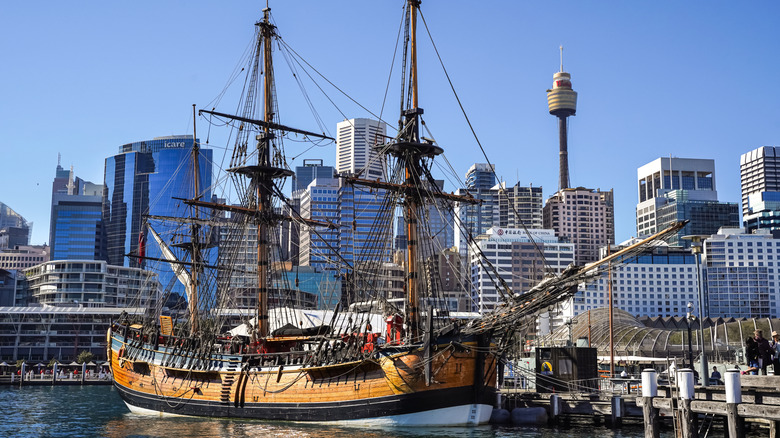How Did The HMS Endeavour Sink And Where Was The Wreck Found?
When talking about legendary ships throughout history, a few notable ones spring to mind. First is the RMS Titanic — which, believe it or not, might disappear during your lifetime. Second is the massive USS Gerald R. Ford (CVN-78), which is the largest aircraft carrier in the world. Third is likely the HMS Endeavour, which was under the command of Captain James Cook as he sailed the Pacific. The Endeavour is also known to have been sunk by the British off the coast of Newport, Rhode Island, in 1778, in a strategic move to discourage French and American attacks.
For centuries, the wreckage of the HMS Endeavour virtually disappeared off the face of the earth. However, that changed in 2025, when the Australian National Maritime Museum (ANMM) and the Rhode Island Marine Archaeology Project confirmed that a wreck previously discovered at an archaeological site designated RI 2394 off the coast of Newport was indeed the Endeavour. Here's everything you need to know about the HMS Endeavour, its impact on history, and how it ultimately met its end.
The HMS Endeavour started out as a coal ship
The HMS Endeavour was launched in Whitby, England, in 1764 under the name Earl of Pembroke. It was constructed from durable Yorkshire oak and initially served as a coal carrier. The ship measured approximately 105 feet in length and 29 feet, 3 inches in width, with a weight of 368 tons. It also featured a flat bottom, which allowed it to beach in shallow waters without needing a dock, and it could carry a large crew and cargo. Aspects like these are what made it the perfect exploration vessel, enabling it to circumnavigate the globe.
Captain Cook would set sail on the ship, bound for Tahiti and the South Pacific. With 93 men on board, the ship set course for its destination. Among the key reasons for the ship's voyage was to search for, explore, and claim the Great Southern Continent. The voyage would result in Cook charting New Zealand and the eastern coast of Australia. It also marked the beginning of the eventual colonization of the Australian continent by the British.
The Endeavour was later renamed
The Endeavour returned to Britain in 1771 and was refitted to be used as a naval transport. With the outbreak of the American Revolutionary War, it was refitted again and renamed Lord Sandwich in 1775. Just three years later, it was strategically sunk off the coast of Newport to foil a French invasion.
Over the years, many wondered where the ship's final resting place was. However, it wasn't until the '90s that experts made the connection between the HMS Endeavour and Lord Sandwich, and the location remained a mystery. The case finally moved forward in 2022, when the Australian National Maritime Museum (ANMM) announced that a specific wreck site in Newport Harbor, known as RI 2394, was confirmed as the resting place of HMS Endeavour. However, the Rhode Island Marine Archeology Project (RIMAP) stated that definitive proof was still pending. (same citation). In 2025, the ANMM confirmed its identification of the shipwreck site RI 2394 as the HM Endeavour.
The HMS Endeavour left a significant impact on the world, from helping botanists study and catalog previously undocumented Australian plants to serving as a pivotal point in European settlement in Australia. For years, its wreckage has lain peacefully on the ocean floor off Rhode Island, at depths between 39 and 43 feet below the surface. Some of the parts of the ship that were successfully discovered include its floors, cannons, and futtocks. If it were still whole and operational, perhaps it would still be in service today, alongside these old but timeless military ships.


